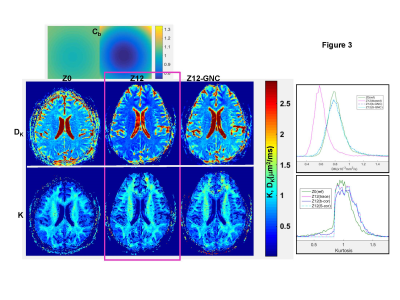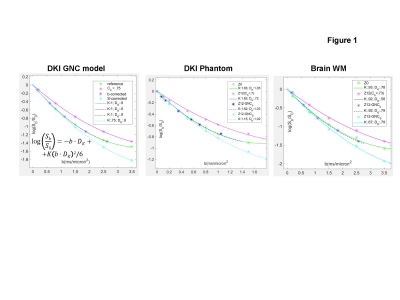Dariya Malyarenko1 and Thomas L Chenevert1
1University of Michigan, Ann Arbor, MI, United States
1University of Michigan, Ann Arbor, MI, United States
Gradient
nonlinearity bias in diffusion weighting b-value
does not affect mean kurtosis parameter for DKI model fit, while biased mean DKI diffusivity can
be corrected using previously developed formalism for mono-exponential
diffusion.

Figure 3: Effect of GNL-induced b-value bias (Cb) on brain DKI
parametric maps (DK – top row, K – bottom row) is compared to
bias-free Z0-reference (left) and corrected Z12-GNC (right). The color-bar
shows common DK(μm2/ms) and K (unitless) scale. The biased (Z12)
maps are outlined with the
magenta box. Parameter histograms from central WM ROIs (defined for K>0.8
on three brain slices near the middle of the axial stack) are shown on the right. The color-codes for reference, biased and
corrected (blue: Eq.[2], cyan: Eq.[3]) histograms are summarized in the legend.

Figure 1: Effect of GNL b-value bias (Cb=.7-.75, magenta)
on DKI signal (log-DWI dependence on b) is compared
to bias-free reference (Cb = 1, green) and bias correction (via b-value, GNCb: blue; and via
DWI intensity, GNCS: cyan) for (left-to-right): analytical model,
phantom (V2 ROI mean) and brain white matter (WM ROI mean). The asterisks mark
DWI data and lines show the corresponding model fits (GNC is dashed). The
legends summarize the model fit parameters and GNL biases, Cb.
